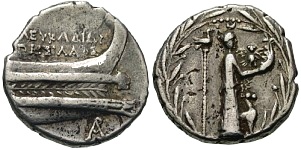Fine Coins Showcase
Antiquities Showcase
Show Empty Categories
Shop Search
Shopping Cart
My FORVM
Contact Us
About Forum
Shopping at Forum
Our Guarantee
Payment Options
Shipping Options & Fees
Privacy & Security
Forum Staff
Selling Your Coins
Identifying Your Coin
FAQs
zoom.asp
Home ▸ Catalog ▸ |Greek Coins| ▸ |Geographic - All Periods| ▸ |Greece| ▸ |Akarnania||View Options:   | | | | | | Acarnania is in west-central Greece along the Ionian Sea, west of Aetolia, with the Achelous River for a boundary, and north of the gulf of Calydon, which is the entrance to the Gulf of Corinth. In Greek mythology it was founded by Acarnan, son of Alcmaeon. In the 7th century B.C., Corinth settled Anactorium, Sollium and Leucas, and Kefalonia settled Astacus. The original inhabitants were driven into the interior, lived in villages, and retired, when attacked, to the mountains. United by the Acarnanian League, their hatred for the Corinthians, who had deprived them of all their best ports, led the Acarnanians to side with the Athenians. The Acarnanians were frequently at war with the Achaeans. They joined the Second Athenian League in 375 B.C. Akarnania sided with the Boeotians in their fight against Sparta, and with Athens against Philip II of Macedon at Chaeronea. In 314 B.C., villages near the Aetolian border were conglomerated into fewer, larger settlements. Still, border conflicts with the Aetolians were frequent, and c. 250 B.C. Acarnania was partitioned between Aetolia and Epirus. After the fall of the king of Epirus, Acarnanian territory that had been given to Epirus regained independence, and Leucas became the capital. The Acarnanians allied with the Macedonian kings. They joined Philip against Rome, and it was not till after the capture of Leucas, their principal town, and the defeat of Philip at the Battle of Cynoscephalae that they submitted to Rome. They supported Antiochus III king of Syria when he invaded Greece in 191 B.C. Upon the expulsion of Antiochus from Greece, they came again under Rome. After the defeat of Perseus in 168 B.C., Leucas was separated from Acarnania, and Thyrreion was made the new capital. In the 1st century B.C., Acarnania suffered greatly from pirates and in Rome's civil wars. After the Battle of Actium, the inhabitants of several towns were removed by Augustus to Nicopolis and Akarnania became merely a part of Epeirus. |


The figure on these Leucadian coins has been identified as a statue of Aphrodite Aineias, whose sanctuary stood on a small island at the northern end of the canal which separated Leucas from the mainland.SH26412. Silver stater, BMC Thessaly p. 180, 99 (bird on arm misdescribed as eagle); Mio II, 83, 34; SNG Cop 381, gVF, toned, weight 8.139 g, maximum diameter 22.0 mm, die axis 345o, Leucas (Lefkada, Greece) mint, c. 167 - 100 B.C.; obverse Aineias' statue of Aphrodite standing right in a long chiton on a low base, Aphlaston and the Armbeuge owl with open wings standing front in right, stag right, scepter surmounted by eagle behind, all in wreath; reverse ΛEYKAΔIΩN / ΠEIΣIΛAOΣ, prow of galley right, ornamented with a lion's head and laurel, AP monogram below; ex Münzen Und Medaillen A.G., ex BCD Collection; very rare variant; SOLD
Argos Amphilochicum, Akarnania, Greece, c. 345 - 300 B.C.


Amphilochian Argos, on the river Inachus at the eastern extremity of the Ambraciot Gulf, was the chief town of ancient Amphilochia. According to traditions cited by Strabo, it was founded after the Trojan War by Alkmeion or his brother Amphilochos. The rival of Ambrakia Arta in the 5th century B.C., it was allied with Athens at the beginning of the Peloponnesian War. The site of Argos has been a subject of dispute. Thucydides says that it was on the sea. Polybius describes it as distant 33 km, and Livy 35 km from Ambracia. William Martin Leake, writing in the 19th century placed it in the plain of Vlikha, at the modern village of Neokhori, where are the ruins of an ancient city, the walls of which were about 1.6 km in circumference.SH29363. Silver stater, BMC Corinth, p. 122, 8; Pegasi II 11, aEF, weight 8.308 g, maximum diameter 22.3 mm, die axis 270o, Argos (near Neochori, Epirus, Greece) mint, c. 345 - 300 B.C.; obverse Pegasus flying left, A below; reverse APΓEI, head of Athena (or Aphrodite) left in plain Corinthian helmet, small Corinthian helmet behind; SOLD
Anaktorion, Akarnania, Greece, c. 350 - 300 B.C.


Anactorium or Anaktorion in ancient Acarnania was on a promontory on the Ambraciot Gulf. On entering the Ambraciot Gulf from the Ionian Sea it was the first town in Acarnania after Actium. It was colonized jointly by the Corinthians and Corcyraeans; but in 432 B.C., the Corinthians obtained sole possession of the place by fraud. It remained in the hands of the Corinthians till 425 B.C., when it was taken by the Acarnanians with the assistance of Athens, and the Corinthian settlers were expelled. It was for some time one of the most important places in this part of Greece. Augustus removed its inhabitants to the town of Nicopolis, which he founded on the opposite coast of Epirus.SH62489. Silver stater, Pegasi II 71, BCD Akarnania 86, BMC Corinth p. 119, 49 ff.; SNG Cop 293, SNG Alpha Bank 528, VF, weight 8.495 g, maximum diameter 20.8 mm, die axis 0o, Anaktorion (near Nea Kamarina, Greece) mint, c. 350 - 300 B.C.; obverse Pegasos flying left, AN monogram below; reverse KΛE, head of Athena (or Aphrodite) left in Corinthian helmet, AΓ monogram below, AN monogram and bucranium ornamented with fillets behind; SOLD
CLICK HERE TO SEE MORE FROM THIS CATEGORY - FORVM's PRIOR SALES



REFERENCES|
Page created in 1.282 seconds.






